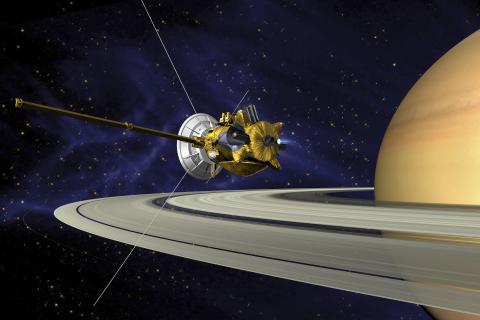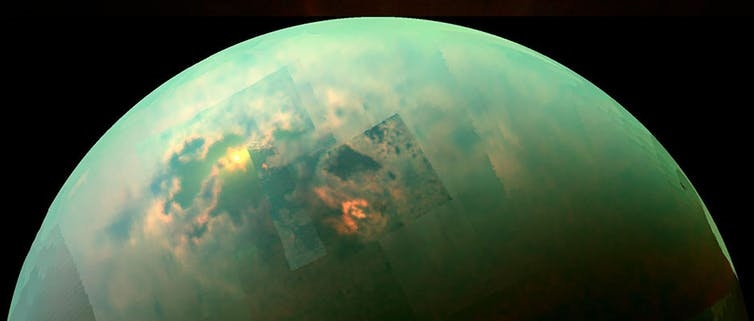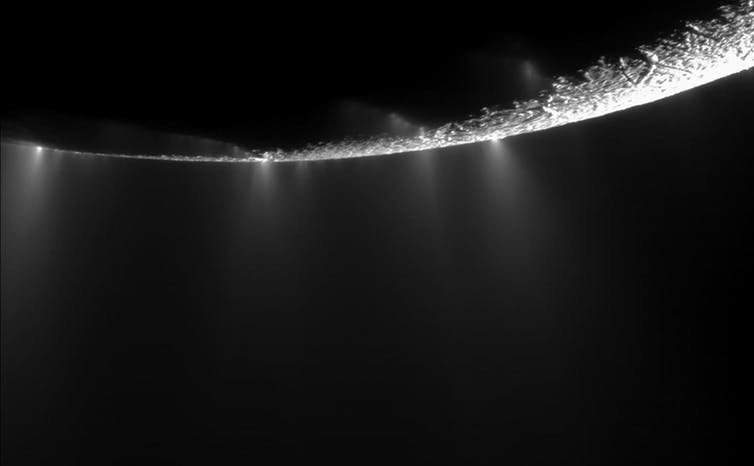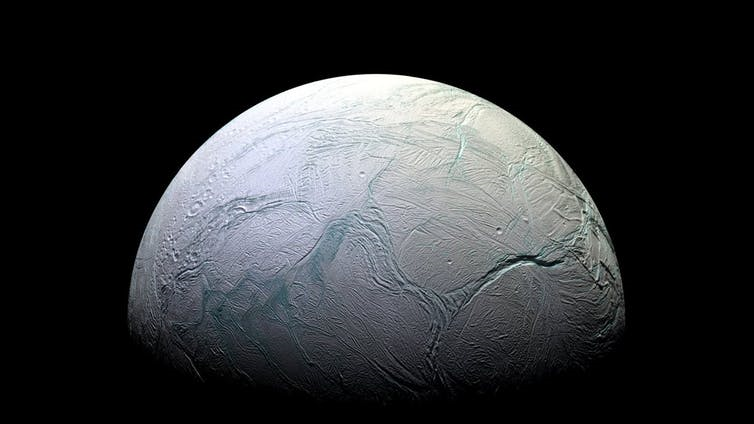Cassini crashes: it’s time for a new mission to explore the possibility of life on Saturn’s moons

NASA’s Cassini mission has made its “death plunge” into the swirling clouds of Saturn after 20 years of exploring the planet and its moons. It’s been amazingly successful, making headlines with groundbreaking discoveries throughout its journey. But today the headlines are more like obituary notices, looking back at the mission’s spectacular achievements.
Cassini discovered new moons around Saturn, found evidence for an ocean below the surface of the moon Enceladus and even managed to land a probe on the satellite Titan (the Huygens probe). It also observed unusual features in the rings of the planet and recorded an enormous, hurricane-like storm whirling around its north pole. Surely, we must now know everything about Saturn and its moons?
Fortunately, scientists are never satisfied, and the answer to one question usually leads to at least three new questions. The discoveries from Cassini and Huygens have resulted in a whole series of issues that require further investigation. Two of the main targets for future exploration are Titan and Enceladus.
Signs of life
Before Huygens parachuted down onto Titan’s surface in January 2005, all we knew about the moon was that it was cold (about 100K or -173.15°C) and had a thick atmosphere (mostly of nitrogen, but with traces of methane), which prevented us from seeing the surface. Huygens revealed networks of valleys and rivers cutting through hills to the shoreline of an inland sea. Subsequent observations by instruments on-board Cassini have given us a greatly expanded understanding of Titan’s landscape – with an entire gazetteer of named features, from mountains to plains and oceans to ponds.
 We must now try to understand what they are, how they formed and how they change with the seasons. We need to learn about tides and ocean icebergs, to define a climate cycle and to determine the composition of the land masses – are they derived from basalt, the most common rock type in the solar system, or are they frozen ice and mud? Does Titan have a rocky core overlain directly by an icy mantle, or does it have an ocean below the surface? If so, is it made up of water?
We must now try to understand what they are, how they formed and how they change with the seasons. We need to learn about tides and ocean icebergs, to define a climate cycle and to determine the composition of the land masses – are they derived from basalt, the most common rock type in the solar system, or are they frozen ice and mud? Does Titan have a rocky core overlain directly by an icy mantle, or does it have an ocean below the surface? If so, is it made up of water?
This all matters because what we have learnt about Titan from Cassini and Huygens has confirmed that it has an active chemistry, based on methane and ammonia. We know that these substances, when irradiated by the sun, result in interesting mixes of chemicals that are precursors to amino acids and other biologically important molecules. The freezing temperature of Titan’s surface precludes anything being alive – but how far below the surface do you have to go before the environment becomes sufficiently balmy for a cryophile to be comfortable? Without a dedicated mission to Titan, we will not find out.
Cassini’s exploration of Titan was always one of the main goals of the mission, with a few larger moons also scheduled for observation. But early in the mission, it became clear that Enceladus should be a prime target too. Anomalies in data observed as the spacecraft flew past Enceladus were subsequently verified as resulting from a large plume of gas and dust venting from the surface close to the south pole.
 This was further investigated by Cassini, flying past Enceladus at different altitudes – the closest of which was at 25km. The data it collected helped scientists resolve the plume into a series of vents through cracks in the surface. It became clear that, like Jupiter’s icy moon Europa, Enceladus was home to an ocean below the icy crust.
This was further investigated by Cassini, flying past Enceladus at different altitudes – the closest of which was at 25km. The data it collected helped scientists resolve the plume into a series of vents through cracks in the surface. It became clear that, like Jupiter’s icy moon Europa, Enceladus was home to an ocean below the icy crust.
Scientists also managed to identify grains of dust, water-rich ice and gases including methane, ammonia and carbon dioxide – plus traces of other organic molecules – in the plume. This lead to to much speculation about the possibility of life in the ocean.
 Like Titan, Enceladus is now recognised as one of the solar system’s most likely locations for extraterrestrial life. A recent report of hydrogen in Enceladus’ plume has given that recognition even greater prominence. That’s because hydrogen is expected to be released as a byproduct of reactions between water and rock. Scientists believe that ocean water on Enceladus collides with rock, becomes heated, reacts chemically and rises up in the ocean via “hydrothermal vents”. That happens in the Earth’s oceans, too. And here, the chemically charged water around these vents supports a rich ecology of microbes and other life forms.
Like Titan, Enceladus is now recognised as one of the solar system’s most likely locations for extraterrestrial life. A recent report of hydrogen in Enceladus’ plume has given that recognition even greater prominence. That’s because hydrogen is expected to be released as a byproduct of reactions between water and rock. Scientists believe that ocean water on Enceladus collides with rock, becomes heated, reacts chemically and rises up in the ocean via “hydrothermal vents”. That happens in the Earth’s oceans, too. And here, the chemically charged water around these vents supports a rich ecology of microbes and other life forms.
A single mission?
Follow-up missions to Saturn, Titan and Enceladus have all been proposed to both the European Space Agency and NASA, but none has yet been accepted and taken forward to the planning stage.
There might be a case for combining a mission to Titan with a mission to Enceladus to investigate the opportunities for life close to Saturn. I am not sure what such a mission would look like. Certainly there should be a spacecraft orbiting Titan and Enceladus, to gather additional information prior to launching vessels to the surface of both moons. Would these vessels be “penetrators” so they could pierce the ice of Enceladus? Or should they be balloons to float down through the atmosphere of Titan? I don’t know, but a possible name for the mission could be EnTiRE – Enceladus and Titan Research and Exploration. You heard it here first…
Of course, one should not forget the “Lord of the Rings” itself. There are still many unknown aspects of the giant planet that would be worth going back to investigate, such as the composition and formation of its unusual rings. And what about that huge, hexagonal-shaped hurricane at the north pole? Is there something comparable at the south pole? How do such weather systems form – and, more to the point, given the current catastrophic hurricanes experienced recently on Earth, can we learn anything from Saturn about our own atmospheric disturbances?
Given the timescale for mission planning, alongside the time it takes to get to the Saturnian system, it will realistically be at least another 20 years before Cassini’s successor arrives. Until then, we will have to rely on the next generation of Earth-based telescopes to help us explore Saturn and its fascinating satellites.
Monica Grady, Professor of Planetary and Space Sciences, The Open University.
This article was originally published on The Conversation. Read the original article.
Contact our news team
For all out of hours enquiries, please telephone +44 (0)7901 515891
Contact detailsNews & articles

OU study: Transplant athletes match elite performance
A new study led by The Open University’s Professor Bart Rienties, and to be published in Progress in Transplantation in December, reveals that high-intensity transplant athletes can not only meet but greatly exceed existing physical activity guidelines.